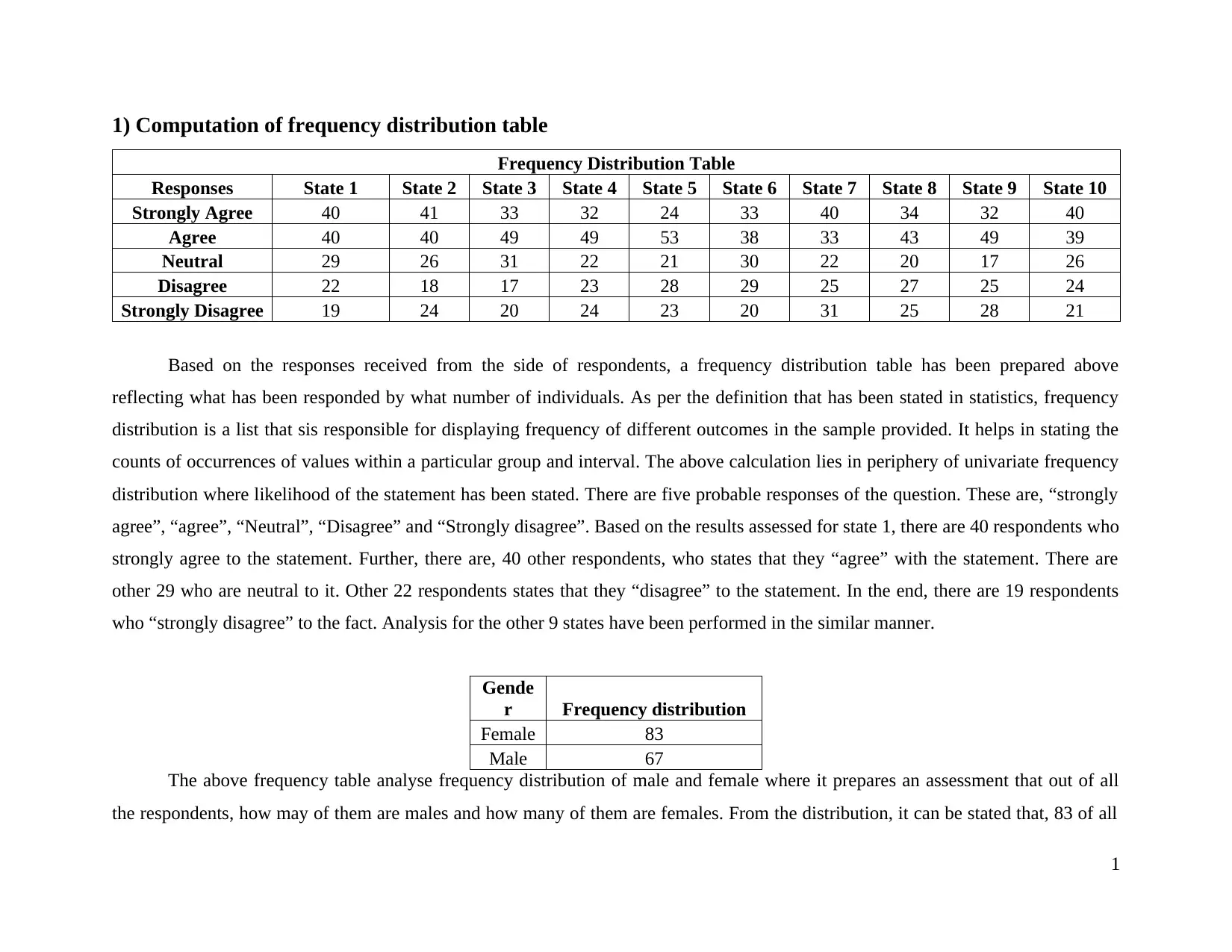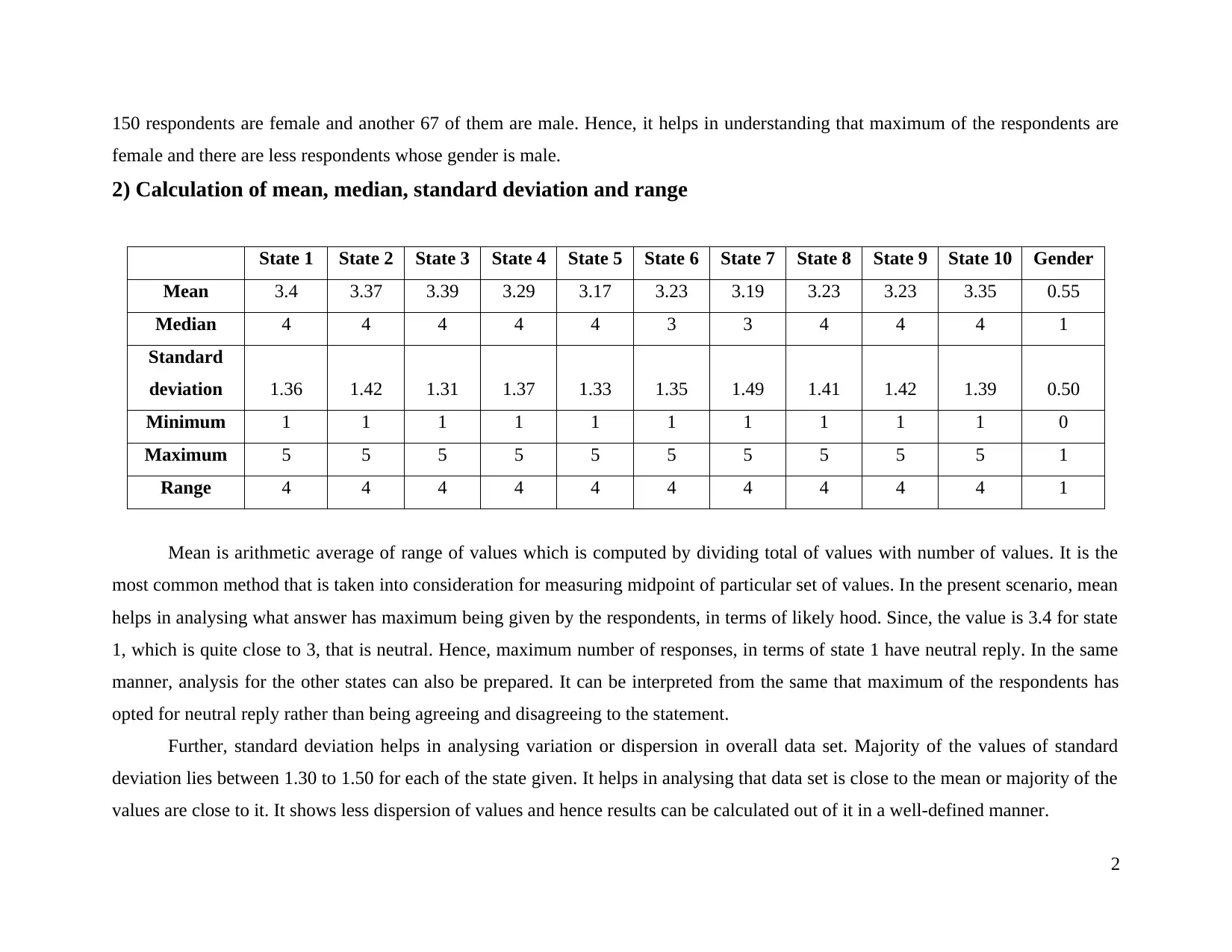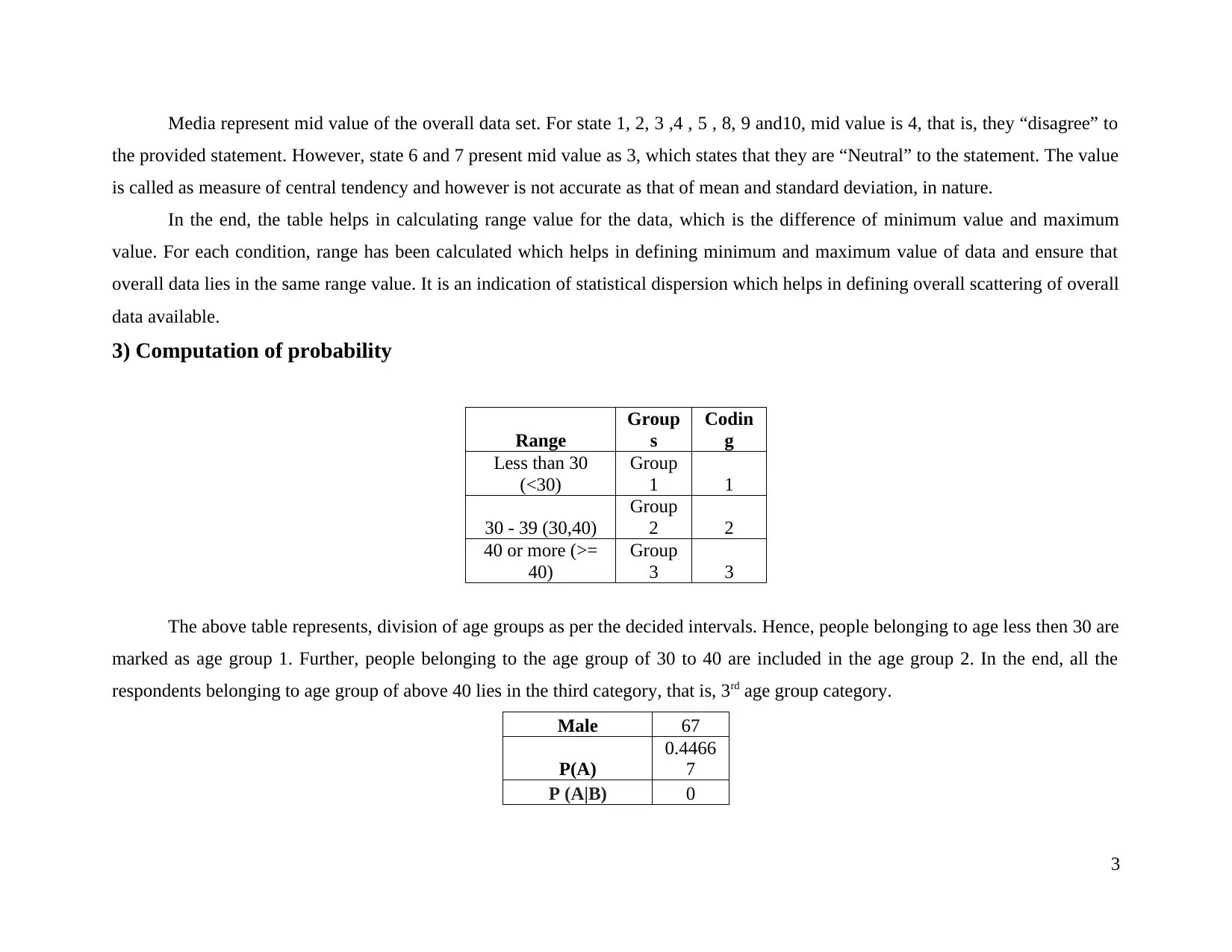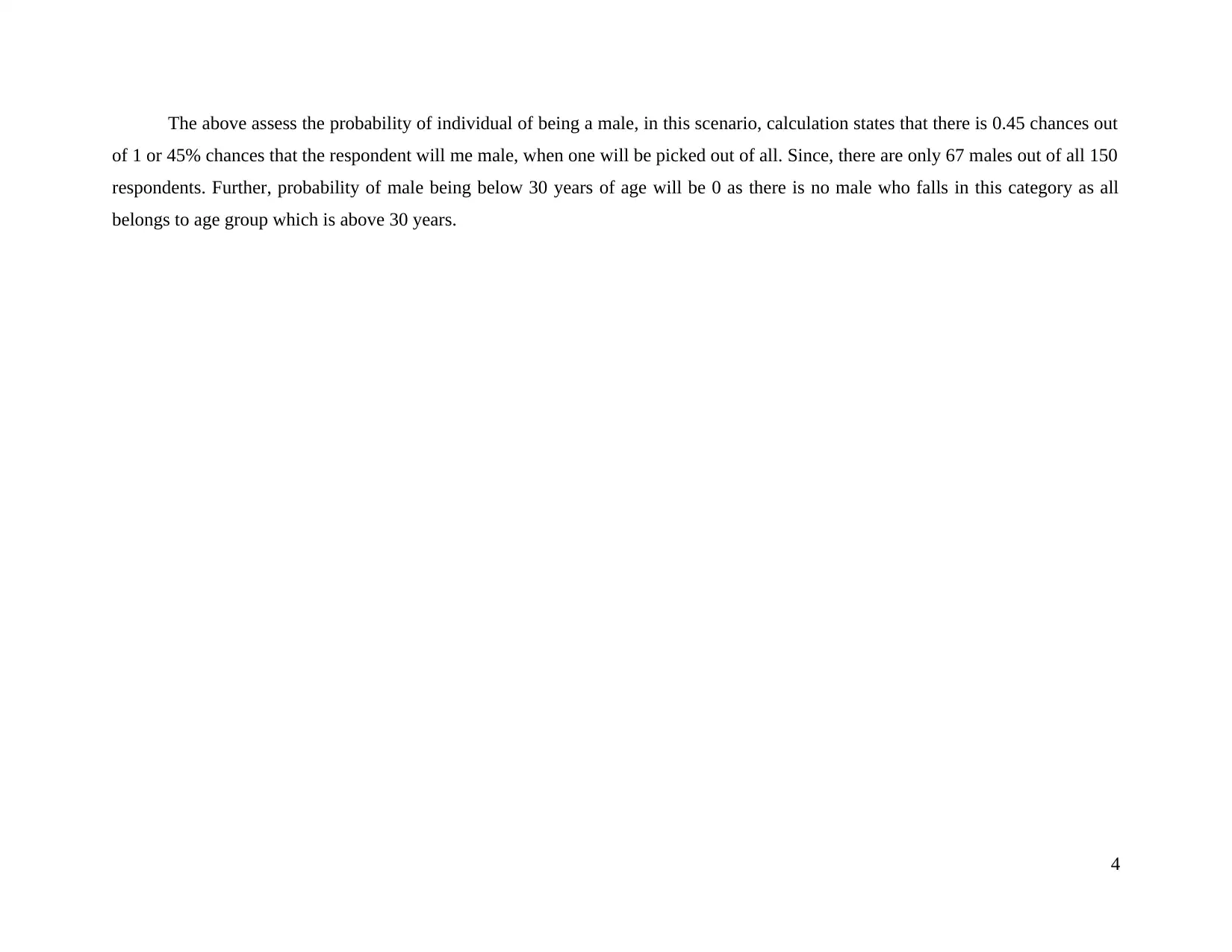Descriptive Statistics Analysis: Project 2A for Management Analytics
VerifiedAdded on 2021/01/02
|6
|1159
|246
Project
AI Summary
This project analyzes a dataset using descriptive statistics. It begins with the creation of a frequency distribution table based on responses from respondents across ten states, categorizing responses into 'Strongly Agree' to 'Strongly Disagree'. The project then calculates and interprets mean, median, standard deviation, and range for each state and for gender distribution. The analysis reveals the central tendency, dispersion, and range of the data, providing insights into the distribution of responses. Finally, the project computes probabilities, including the probability of a respondent being male, and analyzes age group distributions. The project demonstrates the use of statistical methods to summarize and interpret data for management analytics purposes, providing a comprehensive overview of the data's characteristics and patterns.

Management Analytics -
project 2A Descriptive
statistics
project 2A Descriptive
statistics
Paraphrase This Document
Need a fresh take? Get an instant paraphrase of this document with our AI Paraphraser

Table of Contents
1) Computation of frequency distribution table...............................................................................1
2) Calculation of mean, median, standard deviation and range.......................................................2
3) Computation of probability.........................................................................................................3
1) Computation of frequency distribution table...............................................................................1
2) Calculation of mean, median, standard deviation and range.......................................................2
3) Computation of probability.........................................................................................................3

1) Computation of frequency distribution table
Frequency Distribution Table
Responses State 1 State 2 State 3 State 4 State 5 State 6 State 7 State 8 State 9 State 10
Strongly Agree 40 41 33 32 24 33 40 34 32 40
Agree 40 40 49 49 53 38 33 43 49 39
Neutral 29 26 31 22 21 30 22 20 17 26
Disagree 22 18 17 23 28 29 25 27 25 24
Strongly Disagree 19 24 20 24 23 20 31 25 28 21
Based on the responses received from the side of respondents, a frequency distribution table has been prepared above
reflecting what has been responded by what number of individuals. As per the definition that has been stated in statistics, frequency
distribution is a list that sis responsible for displaying frequency of different outcomes in the sample provided. It helps in stating the
counts of occurrences of values within a particular group and interval. The above calculation lies in periphery of univariate frequency
distribution where likelihood of the statement has been stated. There are five probable responses of the question. These are, “strongly
agree”, “agree”, “Neutral”, “Disagree” and “Strongly disagree”. Based on the results assessed for state 1, there are 40 respondents who
strongly agree to the statement. Further, there are, 40 other respondents, who states that they “agree” with the statement. There are
other 29 who are neutral to it. Other 22 respondents states that they “disagree” to the statement. In the end, there are 19 respondents
who “strongly disagree” to the fact. Analysis for the other 9 states have been performed in the similar manner.
Gende
r Frequency distribution
Female 83
Male 67
The above frequency table analyse frequency distribution of male and female where it prepares an assessment that out of all
the respondents, how may of them are males and how many of them are females. From the distribution, it can be stated that, 83 of all
1
Frequency Distribution Table
Responses State 1 State 2 State 3 State 4 State 5 State 6 State 7 State 8 State 9 State 10
Strongly Agree 40 41 33 32 24 33 40 34 32 40
Agree 40 40 49 49 53 38 33 43 49 39
Neutral 29 26 31 22 21 30 22 20 17 26
Disagree 22 18 17 23 28 29 25 27 25 24
Strongly Disagree 19 24 20 24 23 20 31 25 28 21
Based on the responses received from the side of respondents, a frequency distribution table has been prepared above
reflecting what has been responded by what number of individuals. As per the definition that has been stated in statistics, frequency
distribution is a list that sis responsible for displaying frequency of different outcomes in the sample provided. It helps in stating the
counts of occurrences of values within a particular group and interval. The above calculation lies in periphery of univariate frequency
distribution where likelihood of the statement has been stated. There are five probable responses of the question. These are, “strongly
agree”, “agree”, “Neutral”, “Disagree” and “Strongly disagree”. Based on the results assessed for state 1, there are 40 respondents who
strongly agree to the statement. Further, there are, 40 other respondents, who states that they “agree” with the statement. There are
other 29 who are neutral to it. Other 22 respondents states that they “disagree” to the statement. In the end, there are 19 respondents
who “strongly disagree” to the fact. Analysis for the other 9 states have been performed in the similar manner.
Gende
r Frequency distribution
Female 83
Male 67
The above frequency table analyse frequency distribution of male and female where it prepares an assessment that out of all
the respondents, how may of them are males and how many of them are females. From the distribution, it can be stated that, 83 of all
1
⊘ This is a preview!⊘
Do you want full access?
Subscribe today to unlock all pages.

Trusted by 1+ million students worldwide

150 respondents are female and another 67 of them are male. Hence, it helps in understanding that maximum of the respondents are
female and there are less respondents whose gender is male.
2) Calculation of mean, median, standard deviation and range
State 1 State 2 State 3 State 4 State 5 State 6 State 7 State 8 State 9 State 10 Gender
Mean 3.4 3.37 3.39 3.29 3.17 3.23 3.19 3.23 3.23 3.35 0.55
Median 4 4 4 4 4 3 3 4 4 4 1
Standard
deviation 1.36 1.42 1.31 1.37 1.33 1.35 1.49 1.41 1.42 1.39 0.50
Minimum 1 1 1 1 1 1 1 1 1 1 0
Maximum 5 5 5 5 5 5 5 5 5 5 1
Range 4 4 4 4 4 4 4 4 4 4 1
Mean is arithmetic average of range of values which is computed by dividing total of values with number of values. It is the
most common method that is taken into consideration for measuring midpoint of particular set of values. In the present scenario, mean
helps in analysing what answer has maximum being given by the respondents, in terms of likely hood. Since, the value is 3.4 for state
1, which is quite close to 3, that is neutral. Hence, maximum number of responses, in terms of state 1 have neutral reply. In the same
manner, analysis for the other states can also be prepared. It can be interpreted from the same that maximum of the respondents has
opted for neutral reply rather than being agreeing and disagreeing to the statement.
Further, standard deviation helps in analysing variation or dispersion in overall data set. Majority of the values of standard
deviation lies between 1.30 to 1.50 for each of the state given. It helps in analysing that data set is close to the mean or majority of the
values are close to it. It shows less dispersion of values and hence results can be calculated out of it in a well-defined manner.
2
female and there are less respondents whose gender is male.
2) Calculation of mean, median, standard deviation and range
State 1 State 2 State 3 State 4 State 5 State 6 State 7 State 8 State 9 State 10 Gender
Mean 3.4 3.37 3.39 3.29 3.17 3.23 3.19 3.23 3.23 3.35 0.55
Median 4 4 4 4 4 3 3 4 4 4 1
Standard
deviation 1.36 1.42 1.31 1.37 1.33 1.35 1.49 1.41 1.42 1.39 0.50
Minimum 1 1 1 1 1 1 1 1 1 1 0
Maximum 5 5 5 5 5 5 5 5 5 5 1
Range 4 4 4 4 4 4 4 4 4 4 1
Mean is arithmetic average of range of values which is computed by dividing total of values with number of values. It is the
most common method that is taken into consideration for measuring midpoint of particular set of values. In the present scenario, mean
helps in analysing what answer has maximum being given by the respondents, in terms of likely hood. Since, the value is 3.4 for state
1, which is quite close to 3, that is neutral. Hence, maximum number of responses, in terms of state 1 have neutral reply. In the same
manner, analysis for the other states can also be prepared. It can be interpreted from the same that maximum of the respondents has
opted for neutral reply rather than being agreeing and disagreeing to the statement.
Further, standard deviation helps in analysing variation or dispersion in overall data set. Majority of the values of standard
deviation lies between 1.30 to 1.50 for each of the state given. It helps in analysing that data set is close to the mean or majority of the
values are close to it. It shows less dispersion of values and hence results can be calculated out of it in a well-defined manner.
2
Paraphrase This Document
Need a fresh take? Get an instant paraphrase of this document with our AI Paraphraser

Media represent mid value of the overall data set. For state 1, 2, 3 ,4 , 5 , 8, 9 and10, mid value is 4, that is, they “disagree” to
the provided statement. However, state 6 and 7 present mid value as 3, which states that they are “Neutral” to the statement. The value
is called as measure of central tendency and however is not accurate as that of mean and standard deviation, in nature.
In the end, the table helps in calculating range value for the data, which is the difference of minimum value and maximum
value. For each condition, range has been calculated which helps in defining minimum and maximum value of data and ensure that
overall data lies in the same range value. It is an indication of statistical dispersion which helps in defining overall scattering of overall
data available.
3) Computation of probability
Range
Group
s
Codin
g
Less than 30
(<30)
Group
1 1
30 - 39 (30,40)
Group
2 2
40 or more (>=
40)
Group
3 3
The above table represents, division of age groups as per the decided intervals. Hence, people belonging to age less then 30 are
marked as age group 1. Further, people belonging to the age group of 30 to 40 are included in the age group 2. In the end, all the
respondents belonging to age group of above 40 lies in the third category, that is, 3rd age group category.
Male 67
P(A)
0.4466
7
P (A|B) 0
3
the provided statement. However, state 6 and 7 present mid value as 3, which states that they are “Neutral” to the statement. The value
is called as measure of central tendency and however is not accurate as that of mean and standard deviation, in nature.
In the end, the table helps in calculating range value for the data, which is the difference of minimum value and maximum
value. For each condition, range has been calculated which helps in defining minimum and maximum value of data and ensure that
overall data lies in the same range value. It is an indication of statistical dispersion which helps in defining overall scattering of overall
data available.
3) Computation of probability
Range
Group
s
Codin
g
Less than 30
(<30)
Group
1 1
30 - 39 (30,40)
Group
2 2
40 or more (>=
40)
Group
3 3
The above table represents, division of age groups as per the decided intervals. Hence, people belonging to age less then 30 are
marked as age group 1. Further, people belonging to the age group of 30 to 40 are included in the age group 2. In the end, all the
respondents belonging to age group of above 40 lies in the third category, that is, 3rd age group category.
Male 67
P(A)
0.4466
7
P (A|B) 0
3

The above assess the probability of individual of being a male, in this scenario, calculation states that there is 0.45 chances out
of 1 or 45% chances that the respondent will me male, when one will be picked out of all. Since, there are only 67 males out of all 150
respondents. Further, probability of male being below 30 years of age will be 0 as there is no male who falls in this category as all
belongs to age group which is above 30 years.
4
of 1 or 45% chances that the respondent will me male, when one will be picked out of all. Since, there are only 67 males out of all 150
respondents. Further, probability of male being below 30 years of age will be 0 as there is no male who falls in this category as all
belongs to age group which is above 30 years.
4
⊘ This is a preview!⊘
Do you want full access?
Subscribe today to unlock all pages.

Trusted by 1+ million students worldwide
1 out of 6
Related Documents
Your All-in-One AI-Powered Toolkit for Academic Success.
+13062052269
info@desklib.com
Available 24*7 on WhatsApp / Email
![[object Object]](/_next/static/media/star-bottom.7253800d.svg)
Unlock your academic potential
Copyright © 2020–2025 A2Z Services. All Rights Reserved. Developed and managed by ZUCOL.




